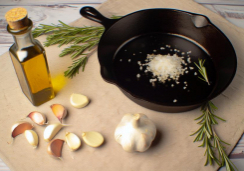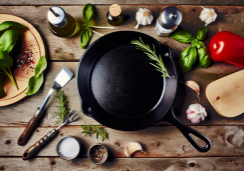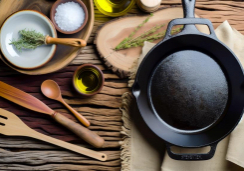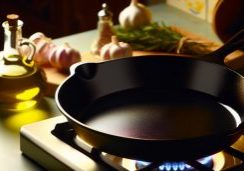7 Essential Gluten-Free Baking Tips & Delicious Recipes
Just as Odysseus navigated the treacherous waters of the Mediterranean, you must embark on your own epic journey through the world of gluten-free baking. You'll find that the absence of gluten doesn't mean a compromise on taste or texture, but it does call for a different set of skills and knowledge.
Together, we'll explore the nuances of gluten-free flours, the critical importance of hydration, and how to perfectly balance the oven's heat to turn out delectable baked goods that'll make even skeptics reach for seconds.
With these seven essential tips and a trove of recipes at your fingertips, you're well on your way to mastering this art. However, the path is sprinkled with both triumphs and challenges, and it's the latter we'll need to address, ensuring that your next batch of gluten-free bread rises as majestically as the phoenix from its ashes.
Mastering Gluten-Free Flours
Selecting the right gluten-free flour is crucial, as it lays the foundation for the texture and flavor of your baked goods. You've got two paths: whip up your own mix or grab a one-to-one GF Flour blend off the shelf. If you're eyeing those store-bought mixes, check for xanthan gum or guar gum on the ingredient list. They're your secret agents for mimicking gluten's binding abilities. But remember, moderation is key—add just ½ teaspoon of xanthan or guar gum per cup of flour to dodge that gummy, gelatinous pitfall.
When you're measuring out your gluten-free flour blends, precision is your best friend. Ditch the cups and reach for a kitchen scale; you'll want those grams and ounces for spot-on accuracy. Spoon that flour into the measuring cup and level it off without packing it down—this isn't the time for heavy-handedness.
And here's a golden nugget of advice: don't shy away from mixing your batter well. Without gluten in the equation, you won't overwork the dough, so mix away! This extra effort pays off, ensuring your batters are well-aerated and ready to rise to the occasion.
Hydration and Resting Batter
While mastering gluten-free flours sets you up for success, giving your batter time to rest can be just as transformative, allowing each grain to fully hydrate and soften for a superior bake. This step is vital because gluten-free flours often call for more liquid to compensate for the lack of gluten's binding properties. By allowing the resting batter a pause, you're ensuring that the liquid is fully absorbed, eliminating any gritty texture that might otherwise mar your culinary creations.
Take note that this resting period isn't just a suggestion—it's a cornerstone for achieving the right texture, especially in gluten-free pancakes and cookies. The difference is palpable: without rest, you might find your treats are unevenly cooked with a less than ideal crumb. But with a good 30-minute rest, your batter will transform, leading to a uniform and pleasing texture that mimics the glutenous treats you're used to.
Overcoming Texture Challenges
When you're baking gluten-free, achieving that perfect, palatable texture can seem elusive. You'll need to master the art of moisture balance, ensuring your baked goods aren't too dry or gummy.
Let's explore how sifting flour, resting batter, and choosing the right bakeware can lead to irresistibly tender gluten-free treats.
Achieving Ideal Consistency
To achieve the perfect texture in gluten-free baking, it's essential to experiment with various moisture-enhancing ingredients and their proportions.
Gluten-free flours often require you to add moisture since they can absorb more liquid than conventional wheat flour. This might mean tweaking recipes by adding an extra tablespoon of oil or water.
A longer mixing time can also work wonders for the consistency of your batter, giving it the structure it needs without gluten's elasticity.
Don't rush—let your batter rest for about 30 minutes before baking; this pause allows the flours to hydrate properly, leading to a better final product.
Always start with recipes crafted for gluten-free flour to ensure consistent results, and don't be afraid to adjust them as you go to address any textural challenges.
Moisture Balance Techniques
Building on the foundation of ideal consistency, mastering moisture balance techniques becomes your next step in overcoming the common texture challenges of gluten-free baking. Since many gluten-free recipes call for more liquid, you'll need to refine your approach to maintain that perfect balance. Here's how you can keep your baked goods moist and delicious:
- Incorporate Pureed Fruits or Dairy: Use pureed fruit, sour cream, or yogurt to add moisture without making your batter too runny.
- Sugar Selection: Swap out white for brown sugar to retain more moisture.
- Moderate Eggs and Oil: Be mindful when adding extra eggs or oil, as they can alter the desired texture.
- Liquid Sweeteners: If you're using honey or agave, adjust other liquids in your gluten-free recipe to compensate.
Each tweak ensures your treats are temptingly tender.
Oven Temperature and Timing
Ensuring your oven is accurately preheated to the right temperature can make all the difference in gluten-free baking, where precision is crucial for perfect results. Unlike traditional baking, gluten-free goods often need a tweak in the baking time. You'll usually find they require a longer baking duration at a lower oven temperature. This adjustment helps avoid unwanted browning while ensuring the inside is fully cooked.
To nail this, you've got to use an oven thermometer—don't just trust your oven's dial. Once you've hit the sweet spot, place your creations in the center of the oven. This ensures they bake evenly from all sides. And remember, depending on the type of pan you're using, you might need to adjust the baking time. Darker pans can absorb more heat, speeding up the cooking process, so always check the manufacturer's advice.
Be extra vigilant when you're trying new recipes. If they're specifically designed for gluten-free baking, they'll likely provide the most accurate guidance for oven temperature and timing. Stick to these, and you're on your way to baking delicious, gluten-free treats that are just as satisfying as their gluten-containing counterparts.
Essential Baking Substitutions
While keeping an eye on oven temperature and timing is vital, you'll also need to master the art of gluten-free substitutions to create exceptional baked goods that cater to dietary restrictions. Navigating gluten-free baking can be a breeze once you're armed with the right substitutes for conventional all-purpose flour and other common ingredients. Here's a primer to get you started:
- Swap Wheat for Gluten-Free Blends: Replace traditional all-purpose flour with gluten-free flours that offer a similar texture and structure. Look for blends that mimic the properties of wheat flour.
- Bind with Gums: Xanthan gum or guar gum can act as binders in your gluten-free recipes, giving your baked goods the elasticity and stickiness that gluten usually provides.
- Butter Alternatives: For dairy-free baking, opt for vegan butter or other dairy-free alternatives that suit the flavor profile of your recipe without compromising texture.
- Egg Replacements: Use chia eggs or aquafaba to substitute for eggs if you're avoiding animal products or have egg allergies. They help in binding and leavening just like regular eggs.
Armed with these substitutions, you'll be able to tackle virtually any recipe and transform it into a gluten-free delight.
Creating Structure and Leavening
In gluten-free baking, you're tasked with replicating the structure and aeration typically provided by gluten.
You'll need to master the use of leavening agents, like baking powder or baking soda combined with an acid, to ensure your baked goods rise appropriately.
Gluten Substitutes for Stability
To create the perfect rise and texture in your gluten-free baked goods, incorporate flour blends with xanthan or guar gum and experiment with leavening agents like baking powder or baking soda. These ingredients are crucial for achieving the structure that gluten typically provides.
Here are some tips to ensure stability in your gluten-free creations:
- Blend gluten-free flours with xanthan gum or guar gum to mimic gluten's binding properties.
- Leaven with a combination of baking powder, baking soda, and sometimes cream of tartar for that ideal lift.
- Add eggs, yogurt, or sour cream for added moisture and stability.
- Enhance structure and moisture with natural sweeteners like honey or agave, or use pureed fruit for best results.
Leavening Agents for Rise
Having covered how xanthan and guar gums can provide the necessary stability in gluten-free baked goods, let's focus on how leavening agents like baking powder and baking soda contribute to the desired rise and structure.
Baking powder is the go-to for many recipes, as it's already balanced to produce carbon dioxide when wet and heated. However, when you need an extra lift, especially with acidic ingredients, baking soda paired with buttermilk or cream of tartar does the trick.
It's a smart move to dissolve these leavening agents in liquid before mixing into your dough or batter—this ensures a more uniform rise. And remember, if you're baking at high altitude, you'll likely need to tweak both leavening agents and liquid proportions to get that perfect rise.
Binding Ingredients Essentials
Binding ingredients like xanthan gum or guar gum are essential in gluten-free baking, providing the structure that gluten normally would and ensuring your creations hold together beautifully. Without these binding ingredients essentials, your baked goods might crumble or fall apart. Remember, gluten-free baking requires a different approach to mimic the properties of gluten.
Here's how you can ensure success:
- Choose the Right Binder: Use xanthan gum or guar gum to give your baked goods the right texture.
- Incorporate Leavening Agents: Add baking powder or baking soda to help your creations rise.
- Add Moisture and Structure: Use eggs, yogurt, or fruit purees as part of your recipe.
- Find the Perfect Flour Blend: Experiment with various gluten-free flour combinations for the best results.
Avoid overmixing, as it's unnecessary and can affect the final product.
Gluten-Free Recipe Favorites
Often, the secret to delicious gluten-free baking lies in a repertoire of tried-and-true favorites that guarantee taste and texture without compromise. You're not just limited to specialty cookbooks; you can convert your favorite recipes to be gluten-free with a few smart tweaks.
Start with gluten-free recipe favorites like moist almond flour brownies or fluffy rice flour pancakes, ensuring you've got a solid foundation for success.
Remember, gluten-free baked goods often require extra moisture, so ingredients like applesauce or Greek yogurt can be your best friends for keeping your treats from turning out dry. Experiment with adding flavorful spices or extracts to elevate the taste. These little adjustments can transform your gluten-free baking, making it just as satisfying as traditional options.
Leavening agents are also crucial, especially at high altitudes. Be precise with baking powder and soda measurements to avoid dense or gummy textures. Keep all your ingredients fresh, as stale flours can ruin the delicate balance you're striving for in gluten-free baking.
Lastly, don't be afraid to get creative. Once you've mastered the basics, branching out into your own adaptations will keep your gluten-free baking repertoire exciting and endlessly delicious.
Conclusion
Now that you're armed with these top gluten-free baking tips, you're ready to tackle any recipe! Remember to choose your flours wisely, hydrate and rest your batter, and be mindful of texture.
Pay attention to oven cues and make smart substitutions. With a little practice, you'll create airy, well-structured treats that'll impress everyone.
Dive into the delicious world of gluten-free baking and watch your creations become instant favorites. Happy baking!










